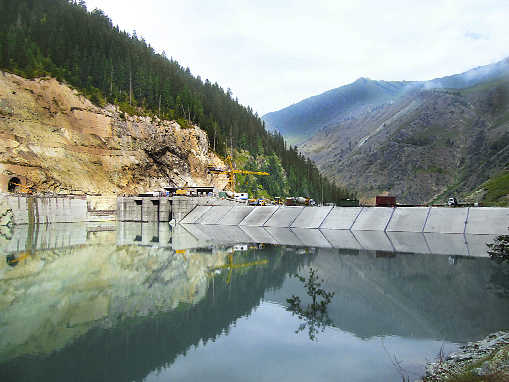
Kishanganga Hydroelectric Power Project Dam site in Gurez valley of Bandipora district in north Kashmir. Tribune photo
Lt-Gen Pramod Grover (retd)
Widely accepted as one of the most sophisticated and comprehensive international water treaties, the Indus Waters Treaty stands out as the world's most generous water-sharing arrangement by far, in terms of both the sharing ratio (80.52 per cent of the aggregate water flows in the Indus system reserved for Pakistan) and the total volume of basin waters for the downstream state. Even the US Senate Foreign Relations Committee Report (2011) refers to this pact as “the world's most successful water treaty”.
The implementation of the provisions of the treaty, however, has not been without intractable divergences and consistent tension between the two parties. Despite India's generosity in the sharing of the Indus river waters, Pakistan has consistently adopted an obstructionist tactics’ strategy since 1977, raising issues regarding run-of-river projects under construction on the western rivers by India.
A case in point is the Kishanganga Hydroelectric Project which is all set to be dedicated to the nation nearly three decades after its conception.
The Kishanganga Hydroelectric Project in Kashmir's Gurez Valley is a run-of-the-river project that includes a 37-metre high concrete rock fill dam across the Kishanganga river, located just before it flows across the Line of Control (LoC) into Pakistan-occupied Kashmir. It will divert the water to an underground powerhouse through a 23.25-km tunnel and will generate 1,713 million units of power per annum, of which the state of Jammu and Kashmir will be provided 12 per cent.
In the early nineties, India had informed Pakistan of its intentions to construct the Kishanganga Hydroelectric Project. After a gap of almost three decades, this 330-MW power project worth Rs 5,750 crore has been commissioned in stages during March-April this year and is likely to be inaugurated by Prime Minister Narendra Modi during the third week of May.
So, what are the reasons for such an unprecedented delay to a relatively small hydroelectric project?
The prime reasons for this have been Pakistan’s consistent efforts to raise objections to the execution of this project, each time requiring India to clarify its position, a long-drawn process, leading every time to further validation of India’s stand. The objections have been rather arbitrary, belying the delay tactics approach of Pakistan for any development in the area. The main objections have been that inter-tributary diversions were barred as per the provisions of the Indus Water Treaty and that existing Pakistani uses must be protected as execution of this project would deprive Pakistan of 27 per cent of the river’s natural flows, thereby adversely affecting 1,33,000 ha of irrigated area in the Neelum valley. Pakistan also raised objections relating to certain design features.
In response, India clarifying its position informed Pakistan that the Kishanganga project on the LoC was a run-of-the-river scheme. The Indus Water Treaty categorically permitted inter-tributary diversion as per Article III (2) and Para 15 (iii) of Annexure D. The treaty stipulated that “where a plant is located on a tributary of the Jhelum of which Pakistan has an agricultural use or hydro-electric use, the water released below the plant may be delivered, if necessary, into another tributary but only to the extent that the then existing agricultural use or hydro-electric use by Pakistan on the former tributary would not be adversely affected”, a clause respected and adhered to by India.
Further, in 2010, Pakistan took the matter to the Permanent Court of Arbitration at The Hague, which stayed the project for three years. But in 2013, the court ruled that the Kishanganga was “a run-of-the-river plant within the meaning of the Indus Waters Treaty and that India may accordingly divert water from the Kishanganga (Neelum River) for power generation.” The court, however, also ruled that India was under an obligation to “construct and operate” the Kishanganga dam in such a way that it “maintains a minimum flow of water in the Kishanganga/Neelum River.” The minimum flow was fixed at 9 cumecs (318 cusecs). India, duly adhering to the observation, voluntarily declared that it was lowering the height of the dam from the planned 98 m to 37m and resumed construction in full swing.
In August 2016, concerned about the performance of their under-construction Neelum-Jhelum hydro station (900 MW) at Nowshera, Pakistan approached the World Bank, the facilitator of the treaty, to prove that India was violating the treaty as well as the court’s verdict. Pakistan requested the World Bank to appoint a court of arbitration to review the design of the Kishanganga project.
India rejected the suggestion on the grounds that Pakistan’s objections were technical in nature and that the matter should be decided by a neutral expert. Pakistan disagreed, arguing that a decision by a technical expert was non-binding and India would be under no obligation to implement the expert’s recommendation. This issue continues to be the focus of several interactions lately under the aegis of the World Bank but no decision has been arrived at since Pakistan’s representation lacks merit and substance. It is thus quite apparent that Pakistan has, once again, lost one more diplomatic battle.
However, for India, there is a need to draw a lesson. It is apparent that a think tank in Pakistan has been consistently resisting the construction of any hydropower project on the western rivers even though all projects by India are the run-of-the-river projects and in tune with the treaty stipulations. India’s stance has, in the past, been accepted by the Neutral Expert in case of Baglihar and the Court of Arbitration in case of Kishanganga.
Taking the benefit of the lessons learnt, there is need to expedite construction/completion of various projects in the pipeline on priority and draw full benefits entitled under the provisions of the treaty for economic growth.



























